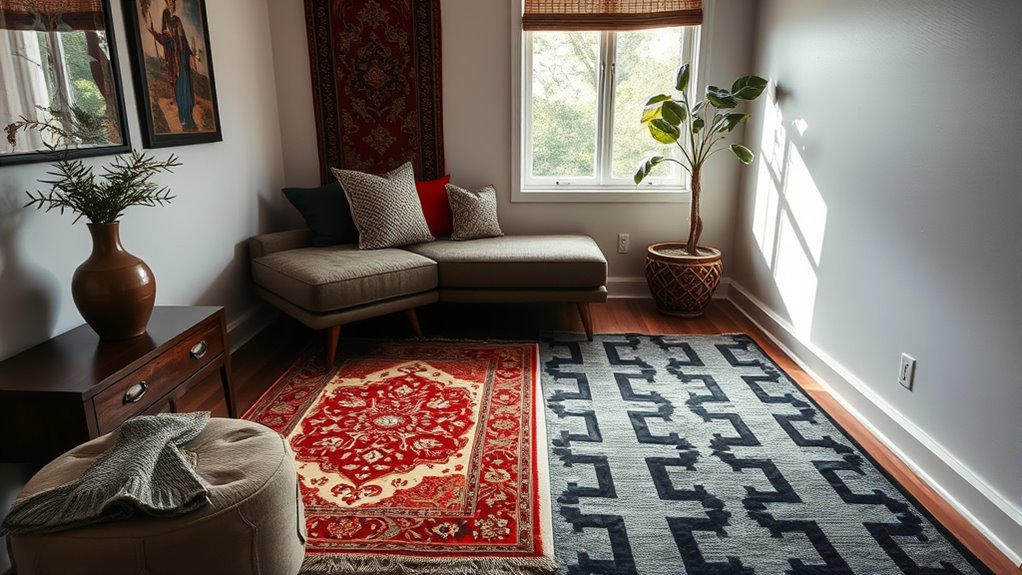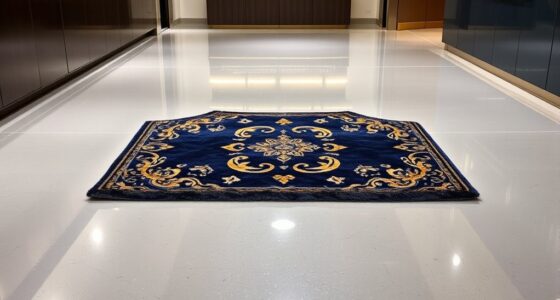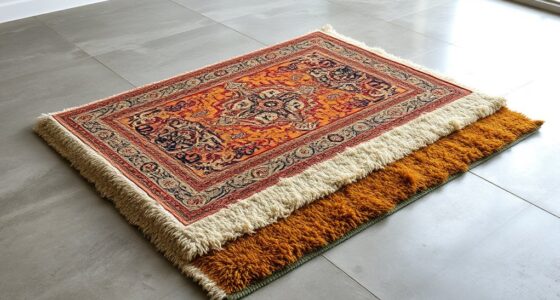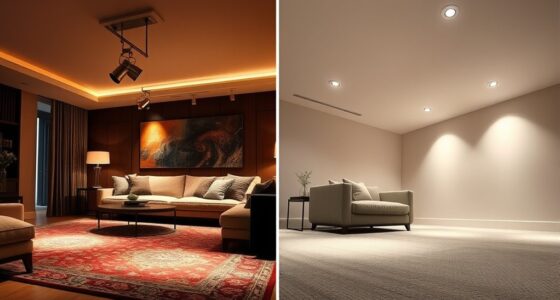When choosing between modern and traditional rug motifs for small spaces, consider your style goals. Modern designs with clean lines and geometric patterns create a sleek, open feel, while traditional floral and medallion patterns add warmth and character. Light colors and simple patterns tend to make rooms look bigger, but traditional motifs can add richness if balanced well. For more tips on making the most of these styles in small spaces, keep exploring your options.
Key Takeaways
- Modern rugs feature minimal patterns, geometric shapes, and bold colors, creating a sleek, spacious feel in small spaces.
- Traditional rugs showcase intricate floral and medallion motifs with warm, rich hues, adding warmth and character.
- Light, neutral tones in modern rugs enhance light reflection and the perception of space; traditional rugs often use deeper, warm colors.
- Larger, simpler motifs in modern designs help make small rooms appear more expansive, while detailed traditional patterns emphasize coziness.
- Blending modern and traditional rug styles can create a balanced, stylish look that enhances small space decor.
Defining Modern and Traditional Rug Motifs
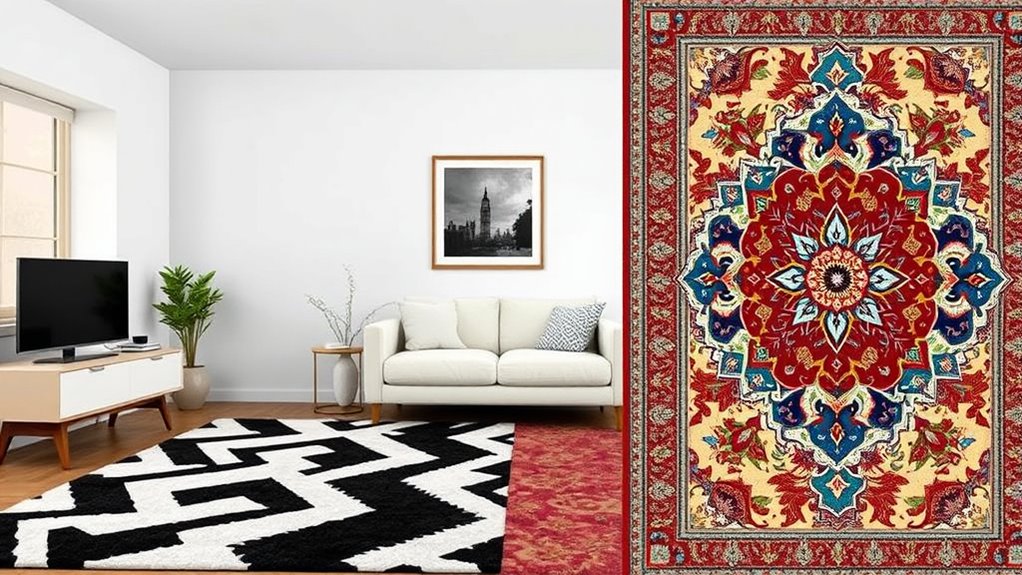
Modern and traditional rug motifs each bring their own distinct style to small spaces. Modern motifs favor simplicity and clean lines, often using geometric shapes, minimal patterns, and bold colors. They emphasize a sleek, contemporary look that can make your space feel open and uncluttered. Traditional motifs, on the other hand, are rich with history and detail. They feature intricate floral patterns, medallions, and elaborate borders, often with more subdued or classic color palettes. These designs evoke a sense of timeless elegance and craftsmanship. Understanding these differences helps you choose a rug that aligns with your style. Modern motifs create a fresh, minimalist vibe, while traditional motifs add warmth and character rooted in heritage. Both styles can transform a small space beautifully when selected thoughtfully. Additionally, considering rug placement and size can enhance the overall impact of your chosen motif.
Visual Characteristics and Patterns

Rug motifs in small spaces are characterized by a variety of visual features that can dramatically influence the room’s atmosphere. Modern motifs often feature geometric shapes, clean lines, and minimalistic patterns, creating a sleek, contemporary look that makes the space feel open and uncluttered. Traditional motifs, on the other hand, tend to showcase intricate floral, medallion, or oriental designs, adding richness and a sense of history. Patterns can vary from bold, large-scale designs to delicate, detailed motifs. The repetition of shapes and symmetry also plays an essential role in shaping the visual impact. Whether you choose modern simplicity or traditional complexity, understanding these visual characteristics helps you select a rug that enhances your small space effectively. Additionally, sound healing science offers insights into how certain patterns and designs can influence our subconscious perception of space, potentially making small areas feel more harmonious and expansive.
Color Palettes and Versatility

Choosing the right color palette for your small space can greatly enhance its sense of openness and harmony. Light, neutral tones like beige, soft grays, or pastels reflect more light, making your room feel larger and more inviting. Modern rugs often feature bold, monochromatic schemes that add a sleek, contemporary touch, while traditional rugs use rich, warm hues to create coziness. Versatility in color allows you to mix and match with various decor styles easily. You can also layer rugs with contrasting shades for visual interest or keep it simple with a single, cohesive palette. The key is selecting colors that complement your furniture and personal style, ensuring the space feels unified and balanced without overwhelming the senses. Incorporating dream-inspired motifs into your rug design can add a unique, artistic element that sparks creativity and personal expression in your small space.
Impact on Space Perception

The right rug motifs can considerably influence how spacious or confined a small room feels. Modern, geometric patterns tend to open up space by drawing the eye outward and creating a sense of movement. They add a contemporary vibe that makes a room feel fresh and uncluttered. Traditional motifs, especially busy or intricate designs, can sometimes make a space seem smaller or more crowded because they draw attention inward and create visual noise. Choosing larger, simpler motifs can help a room look more expansive, while smaller, detailed patterns might emphasize coziness. Additionally, Kia Tuning techniques demonstrate how strategic modifications can optimize visual perception and functionality in small spaces. Overall, your choice of rug pattern can either enhance the perception of openness or add visual weight, so consider how the motifs interact with your room’s size and layout to achieve your desired spatial effect.
Style Compatibility With Small Rooms

Choosing a rug that complements your decor creates a cohesive look in small rooms. Look for patterns that enhance space without overwhelming it, like subtle or geometric designs. Incorporating style cohesion strategies helps your small space feel balanced and inviting. Additionally, selecting appropriate rug motifs can influence the perceived size and harmony of the room.
Visual Harmony With Decor
To create a cohesive look in small rooms, it’s essential that your rug motifs complement your existing decor. If your space features modern furniture and sleek lines, opt for rugs with minimalist patterns or subtle textures that enhance the contemporary vibe. Conversely, if your decor leans toward traditional or vintage styles, choose rugs with intricate motifs or classic designs that echo those themes. Consider your color palette—matching or harmonizing rug colors with your walls, furniture, and accessories creates visual unity. Avoid clashing patterns or overly busy designs that can overwhelm a small space. Instead, select motifs that either blend seamlessly or add a deliberate focal point without overpowering the room’s overall aesthetic. This balance ensures your rug enhances, rather than competes with, your decor. Incorporating interior design basics into your rug selection ensures a well-coordinated and inviting small space.
Space Enhancing Patterns
Ever wondered how certain rug patterns can make a small space feel larger? The right patterns create an illusion of openness and depth. Opt for designs with linear elements or geometric motifs that draw your eye inward, expanding the room’s perceived size. Avoid cluttered or overly busy patterns that can make a space feel cramped. Instead, choose styles that complement your room’s proportions and color scheme. Incorporating self-watering plant pots with similar principles can also enhance the overall ambiance by adding functional style. Here’s a quick comparison:
| Pattern Type | Effect on Space |
|---|---|
| Vertical Stripes | Elevate ceilings, add height |
| Large Geometric | Create focal points, add dimension |
| Light, Repetitive | Enhance openness, avoid overwhelming |
These patterns help you craft a more spacious, inviting atmosphere.
Style Cohesion Strategies
When selecting a rug for a small room, ensuring style cohesion is essential to create a harmonious and balanced space. To achieve this, match the rug’s motifs and colors with your existing décor. If you have a modern aesthetic, opt for rugs with clean lines and minimal patterns that complement your furniture. For traditional spaces, choose rugs with intricate motifs and rich textures that echo classic styles. Keep color schemes unified by choosing rugs that pick up on your room’s dominant hues or serve as subtle accents. Avoid mixing overly busy patterns that clash or overwhelm the space. Instead, aim for a balanced look where the rug enhances your overall design, tying everything together without overpowering the room’s scale. Incorporating regional influences, such as those from Mad Tasting culinary experiences, can also add a unique cultural touch to your décor.
Maintenance and Durability Considerations

When choosing a rug, you need to consider how easy it is to clean and resist stains, especially in small spaces. You also want a rug that can handle regular wear and tear without quickly showing signs of damage. Additionally, think about how well the colors stay vibrant over time to keep your space looking fresh. Incorporating automation’s role in business intelligence can help you analyze the durability and maintenance needs of different rug materials through data-driven insights.
Stain Resistance and Cleaning
Stain resistance is essential when selecting rug motifs for small spaces, as spills and dirt can quickly accumulate in tight areas. Modern rugs often feature stain-resistant treatments or synthetic fibers like nylon and polyester that repel liquids and dirt, making cleanup easier. Traditional rugs, usually made from wool or natural fibers, may require more careful maintenance and prompt cleaning to prevent stains from setting. To keep your rug looking fresh, act quickly when spills occur—blot rather than rub, and use gentle cleaning solutions suited for the fiber type. Regular vacuuming helps remove surface debris, while occasional professional cleaning can restore appearance. Choosing a stain-resistant rug ensures your small space stays clean and vibrant without demanding excessive effort. Additionally, airless paint sprayers offer an efficient way to refresh your walls, further enhancing your small space’s appearance and making maintenance more manageable.
Wear and Tear Resistance
Choosing a rug with strong wear and tear resistance is essential for maintaining its appearance over time, especially in high-traffic small spaces. You want a rug that can withstand daily foot traffic without showing excessive signs of use. Look for durable materials like wool or synthetic fibers such as nylon or polyester, which resist crushing and fraying. Flatweave rugs tend to hold up better under heavy wear, making them ideal for busy areas. Avoid delicate fabrics that wear out quickly, and consider rugs with tight, dense weaves for added resilience. Regularly rotating your rug can also distribute wear evenly, prolonging its life. Investing in a well-made, resistant rug ensures your small space remains stylish and welcoming for years.
Long-term Color Preservation
To keep your rug’s colors vibrant over time, regular maintenance and mindful selection are key. Vacuum your rug frequently to remove dirt and prevent particles from dulling the fibers. Rotate it periodically to ensure even wear and exposure to sunlight, which can fade colors. Choose dyes and materials known for their colorfast qualities, such as wool or synthetic fibers with stable dyes. Avoid placing your rug in direct sunlight for extended periods, as UV rays accelerate fading. When cleaning, use gentle, pH-neutral solutions and avoid harsh chemicals that can strip dyes. Consider applying a protective sealant if appropriate. Regular care, combined with thoughtful material choice, helps preserve your rug’s original hues, keeping it looking fresh and vibrant for years.
Choosing the Right Rug for Your Space

Selecting the right rug for your small space can considerably enhance its appearance and functionality. You want a piece that complements your style while making the room feel welcoming. Consider size: a rug that’s too small can make the space seem disjointed, while one too large may overwhelm. Think about color and pattern—lighter hues can open up the room, while bold motifs add character. Texture also matters; plush rugs bring coziness, while flatweaves keep the space feeling airy. Use this table to guide your choice:
| Feature | Effect |
|---|---|
| Light Colors | Opens up the space |
| Dark Colors | Adds warmth and intimacy |
| Bold Patterns | Creates focal points |
| Neutral Designs | Provides versatility |
| Soft Textures | Invites comfort and relaxation |
Mixing Modern and Traditional Elements
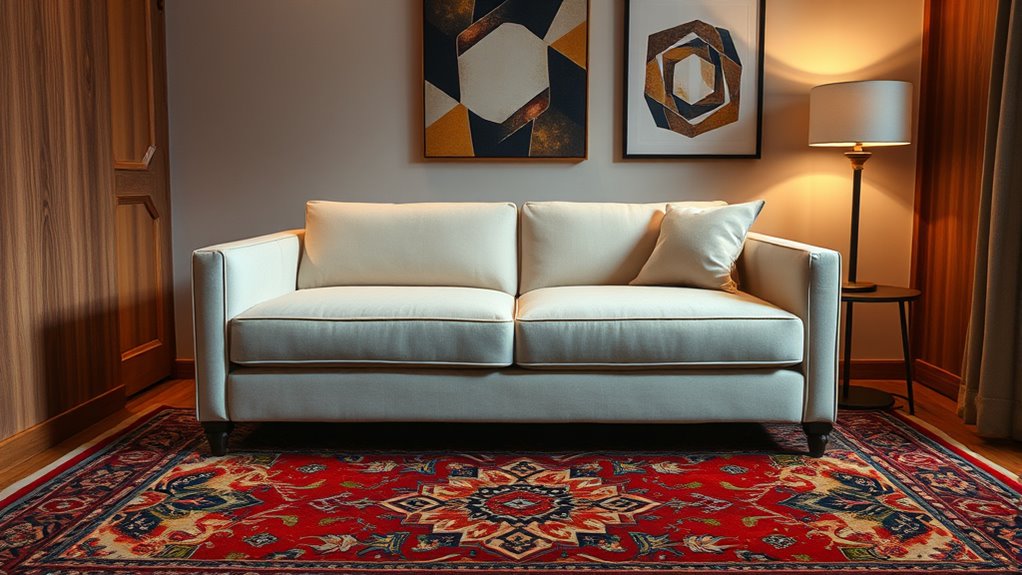
Blending modern and traditional rug styles can create a dynamic and personalized look in your small space. You might pair a sleek, abstract rug with vintage furniture pieces or layer a classic Persian rug under a contemporary coffee table. Mixing these styles adds visual interest and reflects your unique taste. To keep the look cohesive, choose a color palette that ties the elements together, such as neutral tones with pops of bold color. Avoid matching everything perfectly; instead, aim for harmony through contrast. Incorporate accessories like artwork or cushions that echo both styles. This blend not only maximizes your small space but also showcases your creativity. Ultimately, balancing modern and traditional elements makes your room feel curated and full of personality.
Tips for Incorporating Rug Motifs in Small Areas

Combining modern and traditional elements creates a vibrant foundation for your small space, but choosing the right rug motifs can truly enhance the overall look. To do this effectively, start by selecting a motif that complements your existing decor. Keep scale in mind—small, intricate patterns work best in tight spaces. Use bold motifs sparingly to create focal points without overwhelming the room. Mix textures and colors to add depth, but stay cohesive. Finally, layer rugs or pair them with accessories to unify the space. Here are some tips to contemplate:
Balance bold and subtle motifs to enhance your small space with texture, color, and harmony.
- Choose motifs that contrast subtly with your furniture.
- Opt for smaller, detailed patterns to avoid clutter.
- Use accent colors from your decor for harmony.
- Balance bold designs with neutral surrounding elements.
Frequently Asked Questions
How Do Rug Motifs Influence Furniture Choices in Small Rooms?
Rug motifs play a key role in shaping your furniture choices in small rooms. Bold patterns or intricate designs can make a space feel busier, so you might opt for simpler furniture to balance it out. Conversely, subtle motifs allow for more versatile furniture options. By selecting a rug with a specific motif, you influence the overall style and mood, helping you create a cohesive, inviting space that feels well-designed and comfortable.
Can Traditional Motifs Make Small Spaces Feel Cluttered?
Traditional motifs can make small spaces feel cluttered if they’re overly busy or dark, overwhelming the room’s size. But if you choose a traditional rug with lighter colors or simpler designs, it adds charm without cluttering. You can balance traditional patterns with minimalist furniture to keep the space feeling open. So, it’s all about selecting the right motif and balancing it with your decor to avoid a cramped look.
Are There Specific Modern Motifs Suited for Tiny Apartments?
You’re wondering if modern motifs suit tiny apartments? Absolutely! Minimalist patterns, geometric grids, and bold blocks breathe fresh, functional flair into small spaces. You can opt for sleek, simple lines that don’t crowd your room’s corners. Bright, contrasting colors add character without chaos. These modern motifs maximize visual space, making your apartment feel airy and organized. So, go ahead—embrace contemporary designs to craft a cozy, clutter-free haven!
How Do Rug Patterns Affect Natural Light Reflection?
Your rug pattern can considerably influence how natural light reflects in your space. Light-colored, reflective patterns bounce sunlight around, making your room feel brighter and more open. Conversely, darker or matte patterns absorb light, creating a cozy but potentially dimmer atmosphere. Choosing a pattern with subtle textures or shiny accents helps maximize light reflection, enhancing your small space’s brightness and making it feel larger and more inviting.
What Are the Best Ways to Layer Rugs in Small Spaces?
Think of layering rugs like crafting a visual tapestry—you weave textures and patterns to create depth. To do this in small spaces, start with a larger, neutral rug as your base, then add smaller, contrasting pieces on top. Use different shapes and textures to avoid clutter, and make sure they complement each other. This approach makes your space feel cozy yet dynamic, turning a tiny room into a stylish sanctuary.
Conclusion
Choosing between modern and traditional rug motifs is like selecting the perfect brushstroke for your room’s masterpiece. Whether you want a bold statement or a timeless whisper, your rug sets the tone and guides the eye. Think of it as the heartbeat of your small space—pulsing with personality and charm. Trust your instincts, blend your favorites, and let your rug weave a story that feels uniquely yours.
